

Blog - String Calculator kata with Autofixture exercise 5. F# Design Patterns. Mieux comprendre les émotions. Les émotions: amies fidèles ou ennemies incapacitantes?
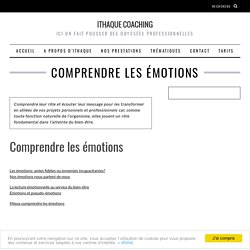
Nos émotions nous parlent de nous La lecture émotionnelle au service du bien-êtreEmotions et pseudo-émotions Mieux comprendre les émotions La lecture émotionnelle au service des relations Collaboration, conflit et lecture émotionnelle De l’importance de la distinction entre stress et émotionsEfficacité professionnelle et émotions Remparts, coursives et échauguettes: les états de défense aux émotions. ASP.NET WebAPI: Getting Started with MVC4 and WebAPI. Download source code - 2.81 MB Introduction I’ve spent the last year working on ASP.NET MVC3 and feeling good this year on MVC4.
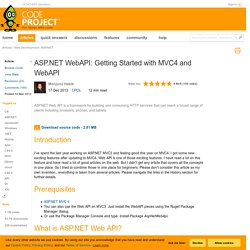
I got some new exciting features after updating to MVC4, Web API is one of those exciting features. I have read a lot on this feature and have read a lot of good articles on the web. About - Nemerle programming language official site. Programming language for "special forces" of developers.

Nemerle is a general-purpose, multi-paradigm programming language for the .Net platform. It is as easy to learn and use as C# or VB.NET but Nemerle is by far more powerful. One may start using it as an advanced C# and then, as learning goes on, employ a range of cool features enabling metaprogramming and functional programming. The metaprogramming is based on macros bearing some similarity to Lisp. Clean Architecture. In the weeks since I started talking about the need to clean up our architecture, I’ve noticed a surprising resistance to the idea. Apparently the notion that it’s a good idea to hide the framework, UI, or database from the application code is not universally accepted. I first blogged about this topic here, I did some short video blogs here, here, and I did a whole cleancoders.com episode on the topic. I’ve also done several keynotes on the topic, the slides for which are here, and a video recording of which is here.
One somewhat dissenting view, written by The Frustrated Architect in his coding {the} architecture blog is here. He shows a picture, which I’ll repeat: The point he’s trying to make is that if the UI and Database are a much larger part of the system than the business rules, then the architecture of the system should be more oriented around those larger elements. NServiceBus - First Hands-On Experience - sfeldman.NET. Tuesday, December 20, 2011 8:28 PM Sean Feldman NServiceBus - First Hands-On Experience I previously blogged on afterthoughts on NServiceBus course. Equipped with new powerful knowledge I have approached on of the TODO tasks on my plate – decouple email notification service from the main web application.
First, the problem with the code that needed to be resolved. A customer is submitting content that has to be approved. Gallery -EventSourcing Store. KsigDo. A Knockout, SignalR, ASP.net, MVVM, MVC and EF all mixed together into a multiuser real time sync To Do" example. The scope of technology used in this example was kind of breath taking, yet Anoop was able to bring it all together, exampling it to us as we followed along...
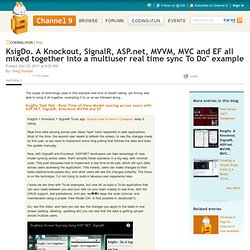
KsigDo = Knockout + SignalR To-do app. Source code is here in Codeplex, keep it handy.Real time data syncing across user views *was* hard, especially in web applications. Most of the time, the second user needs to refresh the screen, to see the changes made by first user, or we need to implement some long polling that fetches the data and does the update manually.Now, with SignalR and Knockout, ASP.NET developers can take advantage of view model syncing across users, that’ll simplify these scenarios in a big way, with minimal code. This post discusses how to implement a real time to-do pad, which will sync data across users accessing the application.
This means, users can make changes to their tasks (add/remove/update etc), and other users will see the changes instantly. ConclusionSurprise, we are done. Sustainable Test-Driven Development: Test Reflexology, Part 1 (first post) Download the Podcast How unit tests inform us about our design As proponents of Test-Driven Development, we constantly seek to identify and point out the various ways that the effort one puts into writing tests will be of value to the development team.

Liz Keogh's blog » Scrum and Kanban: both the same, only different. When I started coaching Agile methodologies, I didn’t know how much I didn’t know.

I had come from Thoughtworks, a company whose tools and processes are mostly driven by Extreme Programming, aka XP. In that respect, most of what I learnt and coached was very similar to Scrum, albeit with different words. We called them iterations instead of sprints, and had stand-ups instead of daily scrums. Tech·Ed North America 2011. Is it Time to Stop Estimating User Stories? Most new Agile teams transition from hours based estimates to relative estimation using story points, but do we even need estimates at all?
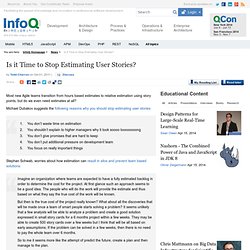
Michael Dubakov suggests the following reasons why you should stop estimating user stories: You don’t waste time on estimation You shouldn’t explain to higher managers why it took soooo loooooooong You don’t give promises that are hard to keep You don’t put additional pressure on development team You focus on really important things Stephan Schwab, worries about how estimation can result in silos and prevent team based solutions: Imagine an organization where teams are expected to have a fully estimated backlog in order to determine the cost for the project. At first glance such an approach seems to be a good idea. Mike Cottmeyer comes to the defence of estimates:
CQRS, l’architecture aux deux visages (partie 1) Dans un article précédent, nous avons vu comment l’approche DDD, via la définition et l’utilisation d’un Ubiquitous Language et d’un véritable modèle du domaine, peut faciliter la communication entre acteurs projet, aider à l’écriture d’un code plus expressif (et donc plus maintenable), et capable d’adresser la complexité – et les changements – du métier.
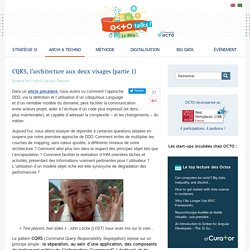
Entity Framework doit-il faire peur aux DBA ? L'arrivée d'Entity Framework avec le Framework .Net permet aujourd'hui aux développeurs d'être encore plus productifs qu'auparavant. Ce gain de productivité intervient tout d'abord sur la construction de son modèle métier. En effet avec la version 4.0 d'Entity Framework Microsoft intègre un designer de modèle très puissant, entièrement intégré à Visual Studio. Mais les fonctionnalités d'un outil de mapping objet relationnel ne s'arrêtent pas là. On parle notamment de SQL dynamique. Un outil ORM doit également permettre de s'abstraire de la source de données en fournissant un langage de requêtage. Tito.Net: n layer web app with Entity Framework 4.1/4.2 - Things to consider.